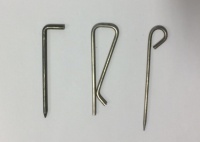Hinges: Difference between revisions
No edit summary |
No edit summary |
||
| (25 intermediate revisions by one other user not shown) | |||
| Line 1: | Line 1: | ||
Loose pin hinges are used as a method of fixing scenery together. They are mostly used for quick scene changes. | |||
[[Image:Pin_hinge.jpg|200px|thumb|left|pin hinge]] | [[Image:Pin_hinge.jpg|200px|thumb|left|loose pin hinge]] | ||
| Line 23: | Line 23: | ||
Loose exhibition pin hinges are better then the simple pin hinges above as the holes are offset which prevents wood splitting. | |||
[[Image:exhibitionhinge.jpg|200px|thumb|left|loose exhibition pin hinge]] | |||
| Line 28: | Line 30: | ||
Backflap hinges are | |||
Loose opera pin hinges are expensive. | |||
[[Image:operahinge.jpg|200px|thumb|left|opera hinge]] | |||
Backflap hinges are one of the most commonly used hinges in theatre, it's uses range from hanging doors and windows to attaching treads and scenery to each other and the stage. | |||
[[Image:Backflap.jpg|200px|thumb|left|backflap]] | [[Image:Backflap.jpg|200px|thumb|left|backflap]] | ||
| Line 47: | Line 93: | ||
Counter hinges | Counter hinges were originally designed for counters and bar tops where the access hatch had to fold back onto the counter. In theatre they are commonly used on stage traps where the trap cover has to fold back onto the stage when being used. | ||
[[Image:Counter_hinge.jpg|200px|thumb|left|counter hinge]] | [[Image:Counter_hinge.jpg|200px|thumb|left|counter hinge]] | ||
| Line 65: | Line 111: | ||
Lift off hinge as the name implies | Lift off hinge, as the name implies, allows the hinged piece to be lifted off. They are useful when a quick change or removal of doors or window shutters are required for a scene change. | ||
[[Image:Lift_off.jpg|200px|thumb|left|lift off hinge]] | [[Image:Lift_off.jpg|200px|thumb|left|lift off hinge]] | ||
| Line 92: | Line 138: | ||
Butt hinge a standard hinge used for hanging doors, especially doors/windows that open onstage. This hinge has to be recessed into the of frame of the door /window for it to work properly. | |||
Butt hinge are a standard hinge used for hanging doors, especially doors/windows that open onstage. This hinge has to be recessed into the of frame of the door /window for it to work properly. | |||
[[Image:But hinge.jpg|200px|thumb|left|butt hinge]] | [[Image:But hinge.jpg|200px|thumb|left|butt hinge]] | ||
Flush hinges have the same uses as butt hinges but do not need recessed as one side (leaf) sits flush into the other. | |||
[[Image:Flush_hinge.jpg|200px|thumb|left|flush hinge]] | |||
Parliament hinges are used when a door or window has to open 270% eg a door or window which has to open all the way forward and end up lying parallel to the flat in which the dorway or window opening is situated, the extended lenght of leaf of this hinge allows this to happen. | |||
[[Image:Parliment.jpg|200px|thumb|left|parliment hinge]] | |||
From left to right Opera Pin, R Pin/R Clip, Simple pin. DO NOT USE NAILS!!! | |||
[[Image:hingepins.jpg|200px|thumb|left|Pins for all hinges]] | |||
Latest revision as of 15:04, 19 January 2017
Loose pin hinges are used as a method of fixing scenery together. They are mostly used for quick scene changes.

Loose exhibition pin hinges are better then the simple pin hinges above as the holes are offset which prevents wood splitting.

Loose opera pin hinges are expensive.

Backflap hinges are one of the most commonly used hinges in theatre, it's uses range from hanging doors and windows to attaching treads and scenery to each other and the stage.
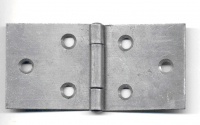
Counter hinges were originally designed for counters and bar tops where the access hatch had to fold back onto the counter. In theatre they are commonly used on stage traps where the trap cover has to fold back onto the stage when being used.
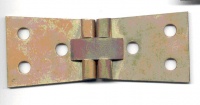
Lift off hinge, as the name implies, allows the hinged piece to be lifted off. They are useful when a quick change or removal of doors or window shutters are required for a scene change.
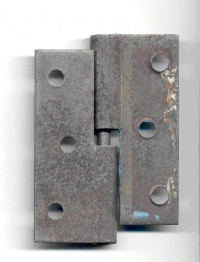
Butt hinge are a standard hinge used for hanging doors, especially doors/windows that open onstage. This hinge has to be recessed into the of frame of the door /window for it to work properly.
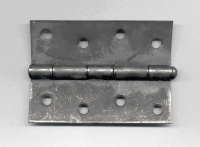
Flush hinges have the same uses as butt hinges but do not need recessed as one side (leaf) sits flush into the other.
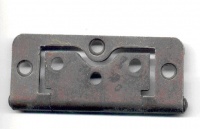
Parliament hinges are used when a door or window has to open 270% eg a door or window which has to open all the way forward and end up lying parallel to the flat in which the dorway or window opening is situated, the extended lenght of leaf of this hinge allows this to happen.
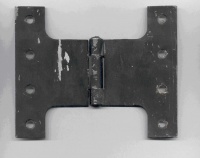
From left to right Opera Pin, R Pin/R Clip, Simple pin. DO NOT USE NAILS!!!
